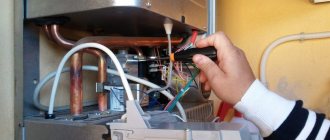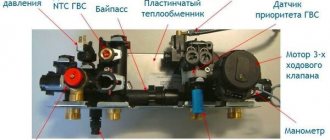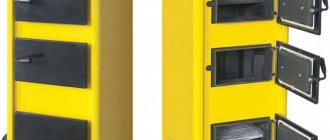METHODS OF PRESERVATION OF BOILERS
If the boiler is stopped for a long time, it must be mothballed.
When preserving boilers, you must follow the manufacturer's instructions for installation and operation. To protect boilers from corrosion, dry, wet and gas preservation methods are used, as well as, in some cases, preservation using the overpressure method.
The dry preservation method is used when the boiler is stopped for a long time and when it is impossible to heat the boiler room in winter. Its essence lies in the fact that after removing water from the boiler, superheater and economizer and cleaning the heating surfaces, the boiler is dried by passing hot air (thorough ventilation) or by lighting a small fire in the firebox. In this case, the safety valve must be open to remove water vapor from the drum and boiler pipes. If a superheater is installed, the drain valve on the superheated steam chamber must be opened to remove any remaining water. After drying is completed, pre-prepared iron trays with quicklime CaO or silica gel (0.5-1.0 kg CaC12, 2-3 kg CaO or 1.0-1.5 kg silica gel per 1 m3) are placed through open holes in the drums boiler volume). The openings of the drum are tightly closed and all fittings are covered. When stopping the boiler for more than 1 year, it is recommended to remove all fittings and install plugs on the fittings. In the future, the condition of the reagents must be checked at least once a month, and then every 2 months, depending on the results of the check, it must be replaced. It is recommended to periodically monitor the condition of the lining and, if necessary, dry it.
Wet method. Wet preservation of boilers is used when there is no danger of water freezing in them. Its essence lies in the fact that the boiler is completely filled with water (condensate) with high alkalinity (caustic soda content 2-10 kg/m3 or triphosphate 5-20 kg/m3). Then the solution is heated to boiling point to remove air and dissolved gases from it and the boiler is tightly closed. The use of an alkaline solution ensures, at a uniform concentration, sufficient stability of the protective film on the metal surface.
Gas method. With the gas preservation method, water is drained from the cooled boiler and the internal heating surface is thoroughly cleaned of scale. After this, the boiler is filled with ammonia gas through the air vent and a pressure of about 0.013 MPa (0.13 kgf/cm2) is created. The effect of ammonia is that it dissolves in the film of moisture that is on the surface of the metal in the boiler. This film becomes alkaline and protects the boiler from corrosion. With the gas method, the personnel carrying out preservation must know the safety rules.
The overpressure method consists in maintaining the steam pressure slightly higher than atmospheric and the water temperature above 100 °C in the boiler, disconnected from the steam lines. This prevents air, and therefore oxygen, which is the main corrosive agent, from entering the boiler. This is achieved by periodically heating the boiler.
When the boiler is put into cold reserve for up to 1 month, it is filled with deaerated water and a slight excess hydrostatic pressure is maintained in it by connecting it to a tank with deaerated water located above. However, this method is less reliable than the previous one.
With all methods of preserving boilers, it is necessary to ensure complete tightness of the fittings; all hatches and manholes must be tightly closed; with the dry and gas method, non-working boilers must be separated from working boilers with plugs. Preservation of equipment and its control are carried out according to special instructions and under the guidance of a chemist.
Instructions for preserving steam and hot water boilers with gas
Gas boiler diagram.
This method is intended for preserving boilers during downtime by reducing the pressure to atmospheric pressure. It is used for the preservation of steam and hot water boilers. During the proposed conservation, the boiler is emptied of water and filled with gas (for example, nitrogen), after which excess pressure is maintained inside the boiler, at the same time, before gas is supplied, it is filled with deaerated water.
The method of preserving a steam boiler involves filling the boiler with gas at an excess pressure in the heating surface of 2-5 kg/cm² while simultaneously displacing water in the drum. In this case, air cannot get inside. According to this scheme, gas (nitrogen) is supplied to the outlet manifolds of the superheater and into the drum. The low excess pressure in the boiler is due to nitrogen consumption.
This method cannot be used when preserving boilers in which the pressure has dropped to atmospheric pressure after shutdown and the water has been drained. There are cases of emergency shutdown of the boiler. During repairs, it is completely emptied, so air gets inside. The specific gravity of nitrogen and air does not differ significantly, therefore, if the boiler is filled with air, it is impossible to replace it with nitrogen. In all areas where air is present and where humidity exceeds 40%, the metal of the equipment will be susceptible to oxygen corrosion.
The small difference in specific gravity is not the only reason. Displacement of air from the boiler and uniform distribution of nitrogen throughout it is also impossible due to the lack of hydraulic conditions, which are caused by the nitrogen supply system (via the outlet manifolds of the superheater and drum). Also in the boiler there are so-called undrained areas that are impossible to fill. Consequently, this method is applicable only after the boiler is operating under load while maintaining excess pressure in it. This is the disadvantage of such a technical solution.
The objective of the boiler preservation method with gas is to increase the reliability and efficiency of boilers that are put into reserve by completely filling the steam-water path with gas, regardless of the shutdown mode. The described preservation method is illustrated by the diagram (image 1). Boiler conservation diagram indicating boiler equipment:
Steam boiler diagram.
- Drum.
- Air balloons.
- Superheater.
- Air balloons.
- Capacitor.
- Air balloons.
- Superheater outlet manifold.
- Remote cyclone.
- Air balloons.
- Screens of boiler circulation panels.
- Economizer.
- Drainage of the lower points of the boiler.
- Superheater outlet chamber vents.
- Nitrogen supply line with valve.
- Air exhaust line from vents with valve.
- Water drainage and supply line with valve.
List of necessary tools, devices, devices:
- Pressure gauges are U-shaped.
- Gas analyzer.
- Set of wrenches.
- Combination pliers.
- Screwdrivers.
- Files.
- Ladder.
- Bucket.
- Solid oil.
- Paronite gaskets.
- Plugs, bolts, nuts, washers.
- First aid supplies and medications.
- Fire extinguisher.
The process of preserving a boiler with gas is carried out as follows (an example of preserving a steam drum boiler is given):
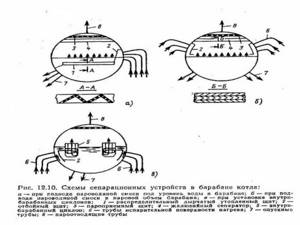
Diagrams of separation devices in the boiler drum.
The boiler is emptied of water after it is stopped by opening all its lower points. After emptying, in some places a steam-air mixture remains, containing oxygen, which causes corrosion of the metal of the boiler equipment. In order to displace the steam-air mixture, all boiler elements (1, 3, 5, 7, 8, 10, 11) are filled with deaerated water. Filling occurs through the lower points (12). Complete filling is controlled by valve (15), after which nitrogen is closed and supplied through valve (14), then through air vents (9, 2, 6, 4, 13).
When supplying nitrogen to the boiler, it is necessary to open the drains of the lower points of all its components. Next, the water is displaced and the boiler is filled with nitrogen. The nitrogen pressure in the boiler is adjusted at the supply line 14 and (if necessary) at the outlet line 16. After the water is completely displaced and the boiler is filled with nitrogen, the excess pressure necessary for preservation is established (25-100 mm water column). Despite the presence of a small amount of deaerated water in some areas of the boiler, the metal of the equipment is not subject to corrosion, this has been proven by research.
Consequently, the proposed method significantly increases the reliability of preservation due to the absolute removal of air from the boiler, filling it with deaerated water and nitrogen with parallel displacement of water.
4.3. WATER BOILERS
4.3.1. Preparing for conservation
4.3.1.1. The boiler is stopped and drained.
4.3.1.2. The selection of conservation process parameters (time characteristics, preservative concentrations at various stages) is carried out based on a preliminary analysis of the state of the boiler, including determination of the value of specific contamination and the chemical composition of deposits on the internal heating surfaces of the boiler.
4.3.1.3. Before starting work, carry out an analysis of the conservation scheme (inspection of equipment, pipelines and fittings used in the conservation process, instrumentation systems).
4.3.1.4. Assemble a scheme for conservation, including a boiler, preservative dosing system, auxiliary equipment, connecting pipelines, pumps. The circuit should be a closed circulation loop. In this case, it is necessary to cut off the boiler circulation circuit from the network pipelines and fill the boiler with water. A boiler acid wash line can be used to feed the preservative emulsion into the preservation circuit.
4.3.1.5. Pressure test the preservation system.
4.3.1.6. Prepare the chemical reagents, glassware and instruments required for chemical analysis in accordance with the analysis methods.
4.3.2. List of monitored and recorded parameters
4.3.2.1. During the conservation process, it is necessary to control the following parameters:
— boiler water temperature;
- when the burners are turned on - the temperature and pressure in the boiler.
4.3.2.2. Indicators for p. . register every hour.
4.3.2.3. Record the start and end times of introduction and the consumption of preservative.
4.3.2.4. The frequency and scope of additional chemical control during the conservation process are given in the table.
4.3.3. Instructions for carrying out conservation work
4.3.3.1. By means of an acid wash pump (APL), circulation is organized in the boiler-ACP-boiler circuit. Next, heat the boiler to a temperature of 110 - 150 °C. Start dosing the preservative.
4.3.3.2. Set the calculated preservative concentration in the circuit. Depending on the test results, periodically dose the preservative. Periodically (every 2 - 3 hours) blow the boiler through the drains of the lower points to remove sludge formed during the equipment preservation process. Stop dosing during purging.
4.3.3.3. By periodically heating the boiler, it is necessary to maintain the parameters required for preservation in the operating circuit (temperature, pressure).
4.3.3.4. After completion of preservation, turn off the dosing system; the recirculation pump remains in operation for 3 - 4 hours.
4.3.3.5. Turn off the recirculation pump and switch the boiler to natural cooling mode.
4.3.3.6. If the technological parameters of conservation are violated, stop the process and begin conservation after restoring the boiler operating parameters.
Care tips and advice
Proper maintenance of the boiler, performed regularly, will help keep it in working condition for a long time and avoid various accidents and accidents. Otherwise, the unit may break even in the first year of operation. Performing several operations will prevent this from happening:
- even during normal operation of the boiler, you need to contact one of the organizations carrying out work in this area, so that a technician inspects the device for gas and water leaks, the condition of the sensors and chimney, and, if necessary, carries out repair work;
- You should always monitor the water pressure inside or at the outlet of the system. If it drops below 0.8 bar, then water needs to be added;
- The addition of water to the system is usually carried out directly through the boiler, where there is a special tap. In this case, the pressure of the added water must be greater than the pressure of water from the boiler. The supplemented water should only be cold (up to 35°C).
Depending on the model and manufacturer, this process will be slightly different due to differences in design. This can be clarified in the instructions supplied with the device.
Technical execution of conservation
The whole procedure consists of three stages. The first involves removing all kinds of contaminants from the surfaces of the equipment, as well as traces of corrosion. If necessary and technically possible, repair operations may also take place. This stage is completed by measures for degreasing surfaces, passivation and drying. The next stage involves treatment with protective agents, which are selected based on the individual requirements of the operation of the technical product. For example, conservation of boilers may involve treatment with heat-resistant compounds, which in the future will provide the structure with optimal resistance to high temperatures. Universal treatment agents include anti-corrosion powders and a liquid inhibitor. The final stage involves packaging the equipment.
Source
Installation of a safety group in the heating system
In the simplest case, the safety group for the boiler is an indicating pressure gauge and a relief (safety) valve. The point of installing a safety group is that in the event of an emergency increase in pressure in the system, the safety valve opens when the permissible pressure is exceeded, and the coolant is released from the system. As a result, the pressure in the system is reduced and destruction of the boiler is prevented. In most cases, you can buy a ready-made (factory-made) security group, but you can also make it yourself. The latter will be most relevant for owners of Russian boilers, since it is not easy to buy a factory safety group for a pressure of 1.5 atm. But the photo below shows the safety group that I made and used in my heating system. The installation location of the security group in the system is immediately behind the boiler (above the boiler).

If you are modernizing yourself, the total costs will not exceed 3-5 thousand rubles, and the work can be done in the summer, when the heating system is not in use. The lifespan of my heating system is about six years. During this time, the following problems emerged:
1. The safety valve leaked, almost within the first week of operation, it was replaced in the store with a new valve (factory defect). 2. About a year after commissioning, the automatic air vent clogged. Replaced it in the summer with a Mayevsky manual tap. The reason, most likely, is the wrong choice of containers for collecting and preparing rainwater. 3. Due to large voltage surges in the electrical network, the gas control system in the boiler room burned out. The case, of course, is not covered by warranty. I had to buy and install a voltage stabilizer on two sockets and re-purchase a gas control system.
There were no other problems associated with the operation of the heating system. For the first year the boiler was operated on solid fuel, currently it operates on natural gas.
Rules for using hot water boilers in a water heating system
The basic rules for installation, installation and operation of the boiler are usually specified in the instructions. Currently, the choice of boiler equipment is quite large and varied, and it is almost impossible to take into account all the nuances in one article. Based on my personal experience, as well as the experience of my relatives and friends, I consider it necessary to note a number of general points that can help the correct operation of the equipment and heating system.
1. The first and simplest thing to do, no matter how funny it may seem to you, is to write instructions for the proper use of the boiler and heating system and place them in the room where this equipment is installed. It is far from a fact that only you personally will operate the system, just as it is not a fact that all your close relatives are well versed in the nuances of the design and operation of the heating system. This is especially true if gas boiler equipment is used, since erroneous actions can lead to the most unpredictable consequences. 2. Secondly, it is necessary to regularly monitor and monitor the operation of the heating system for the simple reason that certain deviations in the operation of the system can promptly signal to the owner that something is wrong. Unfortunately, I have come across cases where the owner not only does not know (does not monitor) the operating parameters of his equipment, but does not even have basic concepts about it.
Recommendations for owners of solid fuel boilers
The main danger in this case is:
1. Boiling of water in the boiler and burning of the walls of the boiler. This is usually due to the fact that the norms for loading solid fuel into the boiler furnace, prescribed in the boiler passport, are violated, and the thermal operating conditions of the boiler are not controlled. 2. The occurrence of smoke or fire. This happens when chimney cleaning is done occasionally. The main danger is that when solid fuel burns, soot forms on the walls of the chimney. In the “simplest” case, it makes it difficult to release flue gases into the atmosphere, which can disrupt the proper operation of the boiler itself. In this case, there is a danger for the residents of the house (in the event of smoke in the living space). In addition, if soot ignites, the combustion temperature of which is very high, a fire in the house itself is possible. Therefore, chimney cleaning should be carried out regularly, at least once a year, before the start of the heating season.
Wet method for heating preservation
The wet method is suitable for preserving boilers and the heating system as a whole. The method is to fill the circuit with a special liquid that will prevent the metal from rusting. If the house is not heated at all and there is a risk of freezing, then only antifreeze (antifreeze liquids based on propylene glycol) can be used as a preservation liquid. Concentrates do not freeze even at -60, but they thicken strongly. They can be diluted to the required consistency, thereby regulating the minimum operating temperature. The disadvantage of antifreeze is that they are expensive, dry out the rubber, have a high degree of fluidity, and turn into acid when overheated.
If you do not plan to use the Buderus gas boiler for several months, then it needs to be mothballed.
The same applies to Buderus solid fuel boilers. According to reviews, this significantly prolongs their life.
If you need to preserve the boiler and there is no risk that the liquid in it will freeze, then in addition to antifreeze, you can use water with added sodium sulfate. Its concentration must be at least 10 g/l. After this, the liquid is heated to remove air from it and all pipes are clogged. The liquid is pumped using a pressure test pump. They are different: manual, automatic, household and professional. We have already written about how to fill the heating system.
Gas pressure adjustment
Measuring and adjusting the minimum and maximum gas pressure will not only achieve proper operation of the boiler, but also save money. The exact pressure range is indicated in the instructions. For wall-mounted boilers it is at least 2 mbar. The maximum pressure is 13 minibar.
If there are no errors, start the gas boiler and open the gas valve. Using a differential pressure gauge, we measure the minimum gas pressure in the system. To measure the maximum possible pressure, turn on the boiler in the “chimney sweep” mode and check the pressure in this mode. If necessary, adjust the pressure to the specified values.
What rules must be followed?
When carrying out measures to preserve boilers in production, they are guided by the requirements set out in RD 34.20.591-97 “Guidelines for the preservation of thermal mechanical equipment.”
The same standards should be observed by owners of equipment installed in private homes.
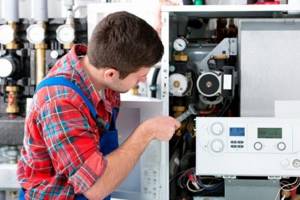
If you are not confident in your knowledge or skills, contact your service organization. Specialists will carry out work to shut down the boiler and preserve the equipment in compliance with all safety requirements
What you need to remember if you decide to mothball your heating or hot water equipment yourself:
- Before any repair work, the gas must be shut off. The main valve is installed at the gas pipeline entry into the house.
- Even the slightest ingress of oxygen into the system will cause corrosion of boiler parts and pipelines, so you need to choose one of the preservation methods and follow it strictly according to the instructions.
- When working with chemical reagents, you must protect your body parts with thick clothing, wear comfortable shoes, gloves and a mask.
- To keep the pipes and components of the unit in working condition, it is necessary to observe the dosage when diluting concentrated compounds and dry chemicals.
- Work with explosive or flammable substances may only be carried out by specialists.
- Upon completion of work, it is necessary to turn off the power supply to additional equipment - for example, a pump.
The above rules must be followed to protect your own health and preserve the equipment.
After a long period of inactivity, the heating and water heating system will require re-preservation - a process that also requires compliance with certain rules.
Wet preservation technology
When carrying out wet conservation of the boiler, you need to ensure that its surface and masonry are dry, and close all hatches tightly. Monitor the concentration of the solution (sodium sulfate content should be at least 50 mg/l). The use of the wet preservation method when carrying out repair work or in the presence of leaks in the boiler is unacceptable, since maintaining tightness is the main condition. If steam leakage is unacceptable with the dry and gas preservation method, then with the wet method it is not so dangerous.
Diagram of a double-turn superheater.
If it is necessary to stop the boiler for a short period, use a simple wet preservation method, filling the boiler and steam heater with deaerated water while maintaining excess pressure. If the pressure in the boiler drops to 0 after stopping it, filling with deaerated water is no longer effective. Then you need to boil the boiler water with the vents open, this is done to remove oxygen. After boiling, if the residual boiler pressure is not lower than 0.5 MPa, preservation can be carried out. This method is used only when the oxygen content in deaerated water is low. If the oxygen content exceeds the permissible value, corrosion of the superheater metal may occur.
Boilers that are switched to reserve immediately after operation can be subjected to the wet preservation method without opening the drums and collectors.
Ammonia in gaseous form can be added to the feed water. A protective film is formed on the surface of the metal, protecting it from corrosion.
In order to prevent the occurrence of corrosion in boilers that have been in reserve for a long time, the wet preservation method is used, maintaining an excess pressure of a nitrogen blanket above the liquid in the boiler, eliminating the possibility of air entering the boiler. In contrast to dry conservation, in which drainage agents operate, drainage from the mine is ensured, and boiler equipment is maintained in a condition suitable for use when necessary. At the time of conservation, write-off of mineral reserves is not permitted.
What rules must be followed?
When carrying out measures to preserve boilers in production, they are guided by the requirements set out in RD 34.20.591-97 “Guidelines for the preservation of thermal mechanical equipment.”
The same standards should be observed by owners of equipment installed in private homes.
If you are not confident in your knowledge or skills, contact your service organization. Specialists will carry out work to shut down the boiler and preserve the equipment in compliance with all safety requirements
What you need to remember if you decide to mothball your heating or hot water equipment yourself:
- Before any repair work, the gas must be shut off. The main valve is installed at the gas pipeline entry into the house.
- Even the slightest ingress of oxygen into the system will cause corrosion of boiler parts and pipelines, so you need to choose one of the preservation methods and follow it strictly according to the instructions.
- When working with chemical reagents, you must protect your body parts with thick clothing, wear comfortable shoes, gloves and a mask.
- To keep the pipes and components of the unit in working condition, it is necessary to observe the dosage when diluting concentrated compounds and dry chemicals.
- Work with explosive or flammable substances may only be carried out by specialists.
- Upon completion of work, it is necessary to turn off the power supply to additional equipment - for example, a pump.
The above rules must be followed to protect your own health and preserve the equipment.
After a long period of inactivity, the heating and water heating system will require re-preservation - a process that also requires compliance with certain rules.
Reasons for turning off the gas boiler
A gas boiler is the real “heart” of a private home. It provides the building with heat, and double-circuit models with hot water.
Thanks to the electronic filling, the main processes - turning on, turning off, switching to another mode, adjusting the temperature - are carried out automatically, without human intervention. The owner needs to set the program by pressing, depending on the manufacturer’s instructions, the appropriate buttons or keys.
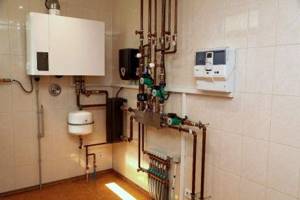
Gas boilers are preferred because of the cheapest fuel - gas. Solid fuel units or wood stoves are more often installed if there is no gas main nearby
Shutting down may be necessary for various reasons:
- moving to another place of residence;
- seasonal shutdown for the warm period;
- emergency shutdown due to boiler breakdown and the impossibility of quick repair or replacement;
- planned stop for maintenance - removing deposits, flushing the internal circuit or cleaning soot;
- connection of other heating or hot water equipment;
- disabling one of the functions - for example, heating, etc.
Most often you need to turn off the heating. To do this, the operation of 1-circuit units is completely stopped, and for 2-circuit units, only one line is shut off - the heating line.
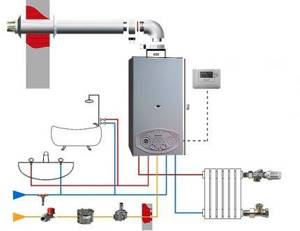
Double-circuit models perform 2 functions: heating and hot water. Since hot water is also required in the summer, the water heating circuit is left in operation, and the hot water supply line continues to be operated as usual
Many modern models have the option of switching to summer mode . At the same time, the boilers do not fail - they also continue to work, maintaining the optimal temperature and keeping the system “ready” for active start-up at any time.
In summer, especially in the northern regions, there are also cold snaps and even frosts, so the existing equipment turns out to be useful.
Where do we start?
A household gas boiler is a powerful and efficient device designed to heat the coolant and circulate the heated liquid through the heating system of the house. Modern boilers heat not only batteries, but also tap water in large volumes, have electronic controls and various safety mechanisms
When buying a boiler, you should pay attention to the heating area so that it is slightly larger than your living space
Naturally, you have already installed the unit itself and made all the necessary connections and piping of the heating system. We checked the chimney and draft, as well as the device itself for proper operation and absence of leaks. This stage of work, as a rule, takes place in the presence of gas industry employees, who carefully record all the results and “give the go-ahead” for the use of this device.
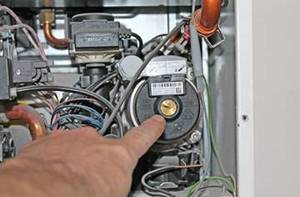
Before starting the boiler itself, it is necessary to fill the heating system - pipes and radiators - with coolant, that is, water. To do this, unscrew the valve at the bottom of the boiler. For different boiler models, the “appearance” of this supply valve may be different, but it cannot be confused with anything else. As a last resort, check the instructions for your device.
By opening the valve, we will begin to supply water to the pipes and radiators. Be sure to monitor the pressure level, wait for the mark of 2 - 2.5 atm. This indicator can be measured using the pressure gauge built into the boiler.
When the required pressure inside the system is reached, it is necessary to bleed off the air that may remain inside the batteries and pipes. Air locks significantly worsen the heat transfer of your battery, is this the result you are trying to achieve?
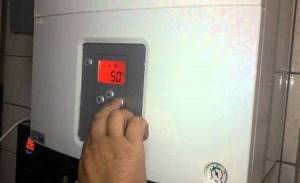
To quickly and effectively bleed air, you need to unscrew the Mayevsky taps on each battery. At first, you will hear a whistling or hissing sound - this is normal. If water starts running out of the radiator, it means there is no air lock.
When you have checked all heating devices, look at what the boiler pressure gauge now shows. The pressure will probably drop slightly and you will need to top up the heating system with water.
But in addition to plugs in the pipes, the normal operation of the boiler can be prevented by the air inside the circulation pump. This is easy to fix. Some models are equipped with an automatic air release system, but, as a rule, it is not effective enough, so it is better to get rid of the air manually the first time.
To do this, remove the front cover from the boiler body, then look for the pump itself - a cylindrical part with a plug for a flat-head screwdriver. Sometimes, the pump is located behind the dashboard, which is easily moved away or removed from the closures. To release air from the pump, turn on the boiler and start heating the water. The boiler will start up. The pump will also begin to engage in the working process - this will be confirmed by incomprehensible gurgling sounds inside the unit - do not be alarmed, this is air. Take a flathead screwdriver and slowly unscrew the plug. When water flows, screw the plug back. This procedure should be carried out several times. When you stop hearing the gurgling of water inside the device and your gas boiler starts working, it means that you have managed to completely get rid of the air inside the pump. At this stage, you should again check the pressure gauge readings with the instructions for the device. In principle, you can stop there - now your boiler will heat water inside the radiators, and if it is a double-circuit unit, then in the water supply.
But it would not be amiss to carry out pressure testing and flushing of the heating system. After these procedures, you will be 100% sure that the inside of the radiators is clean and your heating system has no leaks.
Dry method of preservation of water heaters
Preservation of a boiler room using dry methods provides the same high guarantees of equipment safety as the methods described above. The essence of the matter is to completely dry the internal channels from moisture. You can do this in several ways:
- blow with strong pressure of warm air;
- evaporate moisture.
In the Russian Federation, the Dakon boiler has gained authority, so its sales volumes are constantly growing.
In Italian Ferroli gas boilers, malfunctions occur only in case of improper operation.
You can evaporate the moisture by turning on the burner or lighting a flame in the firebox of an empty (without liquid) boiler. It is important that the flame is very slow so that the heat exchanger does not burn out. Air remains in the heater channels, and there is always moisture in it in the form of steam. This moisture may condense under certain conditions. The presence of moisture in the air, although slowly, still leads to the destruction of the metal. Therefore, you need to add a moisture-absorbing substance. Granular potassium chloride or quicklime is suitable for this. Desiccant powders need to be changed periodically (every two months).
Gas boiler houses

A gas boiler should be chosen if there is a gas main passing nearby. Gas is often the most popular and cheapest type of fuel in our country. It is worth noting that about half of all heating boilers installed in the Russian Federation use this particular fuel. For this type of boiler, you can use liquefied gas in cylinders, but this will increase the cost of its operation due to frequent refills. This heating option can be taken into account when designing, as a backup. The high level of efficiency makes it possible to heat houses with large square footage. Gas boiler houses are easy to use and consume economical fuel, which is its undeniable advantage.
One of the rules for operating boiler houses is: To install a gas boiler, you need to obtain permission from Gazgortekhnadzor, which is not so easy to do. You will need to obtain not only permission to install, but also obtain approval and pay a fee. When arranging such a boiler room, it is necessary to use the services of specialists in the design and installation of a chimney, since the safety of the structure itself depends on it. The room in which the boiler will be located must be equipped with access to the street and have good ventilation. Otherwise, the gas boiler may smoke.
Basic rules for operating boiler rooms with a gas boiler:
- Availability of a separate room (boiler room);
- the boiler room must have an area of at least 4.5 m2, the ceiling height is 2.5 m and above;
- the chimney must be made of acid-resistant and heat-resistant material;
- the upper edge of the chimney (head) must be raised above the level of the roof ridge by at least half a meter;
- horizontal sections of the chimney pipe should not exceed 1 m in length;
- the width of the entrance doors is made at least 80 cm;
- it is imperative to equip the room with a ventilation hole of sufficient area;
- it is necessary to have natural lighting at the rate of at least 0.3 m2 per 10 m2 of boiler room area;
- the presence of a gas analyzer is a must, as it is responsible for analyzing the environment and monitoring air pollution in the room. If the norm is exceeded, it automatically blocks the gas supply to the boiler.
- the boiler must be located at a distance of at least 20 cm from the nearest walls, the surface of which must be protected with fire-resistant material.
5.1. Option 1
5.1.1. The most favorable conditions for turbine preservation are the combination of the normal regime of wet steam washing of the turbine flow part (where provided) with simultaneous dosing of a preservative into the steam or by dosing an aqueous emulsion of a preservative into the slightly superheated steam in front of the turbine with condensate discharge (in an open circuit).
5.1.2. Volumetric steam leaks are selected based on the conditions of maintaining low turbine rotor speeds (taking into account critical frequencies).
5.1.3. The steam temperature in the turbine exhaust pipe must be maintained at least 60 - 70 °C.

